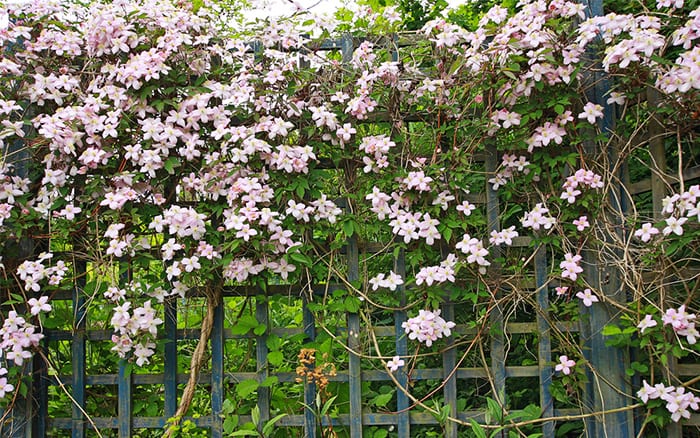Every garden should have a climber. They cover eyesores like walls and fences and add height to beds and borders by growing over arches and pergolas.
You can also use climbing plants to create an immersive seating area, surrounding yourself with colour and fragrance.
How to plant a climber
Before you buy a climber, check the label to make sure it is suited to the position you have chosen. A sun-loving plant will never thrive in shade.
Clear the area of weeds and dig in peat-free compost or well-rotted manure. This is especially important around walls, where the soil if often poor and dry.
Dig a hole about 45cm away from the wall or fence. Remove the plant from its pot, gently tease out the roots and place in the hole. Make sure the top of root ball is at soil level – don’t plant it too deep. Then backfill with soil, firm down and water in.
Tie stems to short bamboo canes at 45 degree angles from the wall. This will keep the plant upright and give it vital support when spring comes around.
Finally, cover the soil with a layer of mulch to suppress weeds and hold in water. You can put a trellis or other support system up in spring if the plant needs it.
How to prune climbers
Many established climbing plants can soon get out of hand. Proper pruning will not only keep them in check, it will encourage stronger regrowth and better flowering.
Prune deciduous climbers in autumn once flowering is finished. But there’s always one exception – prune late-flowering clematis in spring!
Evergreen climbers should be pruned after flowering has finished. Often, these only need a light pruning to keep them in shape.
Read my guide to pruning roses here.
Before you start pruning, determine the overall shape you want and keep this in mind as a guide. Then remove any weak stems or those that are growing in the wrong direction.
Prune the hardier stems more lightly – they give the plant structure and keep the vine strong over winter. Just a tidy up will suffice.
How to tie climbing plants to supports
Many climbing plants need support to keep growing upwards. After you have pruned the plant, check its supports and repair any damage. Trellis should be firmly fixed to the wall or fence.
Check that ties are not cutting into the stems. This can damage the plant, so loosen them to allow it to grow.
Tie stems into supports to hold them up, and to train the plant in the direction you want it to grow. Keep standing back to check the shape.
Protect climbers over winter
Most climbing plants are hardy, but varieties like passion flower can be vulnerable in the cold weather.
Put down a thick layer of bark chip mulch to protect roots from frost. It will rot down and deliver loads of nutrients into the soil. It also suppresses weeds and reduces water loss.



Always informative